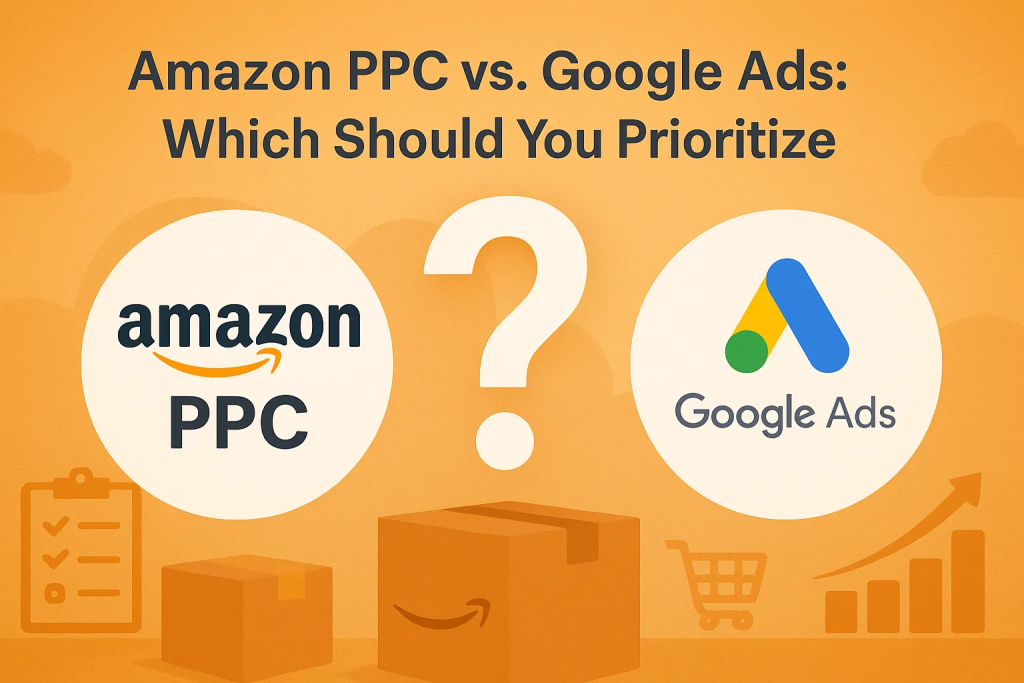
Executive Summary
Alright, so you’re selling online and need to advertise. Amazon PPC and Google Ads are your big options. Amazon PPC? That’s for getting sales right now from people already shopping on Amazon. Google Ads? That’s for building your brand and grabbing leads from all over the web. The best choice? It depends on what you’re selling, who you’re selling to, and what your goals are. Test everything, keep an eye on the numbers, and you’ll figure it out.
Introduction
Let’s be real, if you’re selling online, you need to advertise.
Which platform to choose? Amazon PPC or Google Ads?
We’ll figure out which one makes the most sense for your business, your goals, and where you’re at right now.
Understanding Amazon PPC
What is Amazon PPC and How Does It Work?
Amazon PPC is how you get your stuff seen on Amazon. You only pay when someone clicks. Your ads pop up where people are already looking to buy – prime real estate.
Types of Amazon PPC Ads
- Sponsored Products: These are your bread and butter. They show up in search results and on product pages for individual products.
- Sponsored Brands: Want to build your brand? These ads show your logo, a headline, and a few products at the top of search results.
- Sponsored Display: These ads follow people around the web (retargeting). Good for reminding them about your stuff.
- Sponsored Video: Show off your product in action!
Key Metrics for Amazon PPC
- Advertising Cost of Sales (ACoS): How much you’re spending on ads to get a sale. Lower is better.
- Total Advertising Cost of Sales (TACoS): How much you’re spending on ads compared to all your sales. This gives you a bigger picture.
- Click-Through Rate (CTR): How many people see your ad and click on it.
- Conversion Rate: How many people who click on your ad actually buy something.
- Return on Ad Spend (ROAS): How much money you’re making for every dollar you spend on ads.
Targeting Options Available
- Keyword targeting: Show your ads when people search for specific words.
- Product targeting: Show your ads on specific product pages (like your competitors!).
- Interest-based targeting: Target people based on what they like and buy.
- Remarketing: Chase after those people who looked at your stuff but didn’t buy.
Cost Structure and Bidding Mechanisms
It’s an auction! You bid on clicks. No minimum spend. Start with manual bidding, then try letting Amazon automate it.
Strengths of Amazon Advertising
- People are ready to buy right now.
- Super easy to buy.
- Everything happens on Amazon.
- You can see exactly how much you’re making from your ads.
- Great for selling specific products.
- You can figure out what keywords people are using to find your stuff.
- You don’t even need your own website.
Understanding Google Ads
What is Google Ads and How Does It Work?
Google Ads lets you put ads on Google Search, YouTube, and millions of other websites. Reach customers at every stage of the buying process.
Types of Google Ads Relevant for E-commerce
- Search Ads: Text ads on Google when people search for stuff.
- Shopping Ads: Product ads with pictures, prices, and your store name.
- Display Ads: Banner ads on websites all over the internet.
- YouTube Ads: Video ads on YouTube (before, during, or after videos).
- Discovery Ads: Ads that show up in Google’s feeds (like on your phone).
Key Metrics for Google Ads Campaigns
- Click-Through Rate (CTR): How many people see your ad and click.
- Conversion Rate: How many people who click on your ad do what you want them to do (buy, sign up, etc.).
- Cost Per Click (CPC): How much you pay every time someone clicks.
- Cost Per Acquisition (CPA): How much it costs you to get a customer.
- Return on Ad Spend (ROAS): How much money you make for every dollar you spend.
- Quality Score: Google’s way of rating how good your ads and keywords are.
Targeting Capabilities
- Keyword targeting: Show your ads when people search for certain words.
- Demographic targeting: Target people based on age, gender, location, etc.
- Interest targeting: Find people who are interested in what you’re selling.
- In-market audiences: Target people who are actively looking to buy stuff.
- Customer match: Target your existing customers.
- Remarketing: Show ads to people who have been to your website.
- Similar audiences: Find new people who are like your current customers.
- Geographic targeting: Only show your ads in certain areas.
Cost Structure and Bidding Strategies
It’s another auction! You bid for ad placement. Google offers a bunch of different bidding strategies (manual, automated, etc.).
Strengths of Google Advertising
- HUGE reach.
- You can reach customers at every stage of the buying process.
- Tons of different ad types.
- Super detailed targeting.
- Great for building your brand.
- Drives traffic to your website.
- Tracks people across devices.
- Amazing analytics.
Ad Targeting Mechanism
Amazon PPC Targeting:
- Automatic Targeting: Amazon finds the keywords for you based on your product listing. It’s like letting Amazon do the work, but you have less control. Strategies include close match, loose match, substitutes, and complements.
- Manual Keyword Targeting: You pick the keywords. You have more control, but it takes more work. You can choose broad, phrase, or exact match types.
- Product Targeting: You target specific product pages (like your competitors’ pages!). You can even narrow it down by brand, price, star rating, and Prime shipping.
Google Ads Targeting:
- Keyword Targeting: You pick the keywords, just like on Amazon. You can choose broad, phrase, or exact match types to control how closely the search term needs to match your keyword.
- Demographic Targeting: Target people based on age, gender, location, and even income.
- Interest Targeting: Reach people based on their interests and browsing history. Google knows a lot about what people are interested in.
- Remarketing: Show ads to people who have visited your website or watched your videos.
- Placement Targeting: Choose specific websites or apps where you want your ads to show up.
- Product Data Feed: For Shopping Ads, you upload all your product info to Google Merchant Center. Google uses this to match your products with relevant searches.
Direct Comparison: Amazon PPC vs. Google Ads
Audience Comparison
- Intent Level: Amazon: People are ready to buy. Google: All over the place (research, browsing, buying).
- Reach: Amazon: Just Amazon. Google: The entire internet.
- Demographics: Amazon: Mostly Prime members. Google: Everyone.
Cost Comparison
- Average Cost Per Click: Amazon: $0.30-$1.50 (can be higher). Google: $0.20-$4.00 (depends on the ad type and industry).
- Minimum Spend: Amazon: Technically none, but you need at least $10/day to see results. Google: Same deal.
- ROI Potential: Amazon: Faster ROI. Google: Could be higher in the long run.
Conversion Potential
- Average Conversion Rates: Amazon: 10-15%. Google: 1-5% (depends on the ad type).
- Path to Purchase: Amazon: Super quick. Google: Takes more steps.
Platform Management
- Ease of Setup: Amazon: Easier to get started. Google: More complicated.
- Campaign Management: Amazon: More straightforward. Google: More time-consuming.
Reporting and Analytics
- Data Detail: Amazon: Decent, but doesn’t tell you the whole story. Google: Tons of data.
Platform Integration
- Ecosystem Connection: Amazon: Everything’s on Amazon. Google: Connects to everything.
Comparison Table: At a Glance
| Feature | Amazon PPC | Google Ads |
|---|---|---|
| Primary Strength | Converting bottom-funnel | Full-funnel marketing |
| Best For | Direct product sales | Brand building and website traffic |
| Purchase Intent | Very high | Varies (low to high) |
| Audience Reach | ~300M active customers | 4B+ users across properties |
| Avg. Conversion Rate | 10-15% | 1-5% (varies by format) |
| Typical CPC Range | $0.30-$1.50 | $0.20-$4.00 (varies by format) |
| Website Required | No | Yes |
Strengths and Limitations
Amazon PPC:
- Strengths: Perfect for grabbing shoppers ready to buy on Amazon, high conversion rates, great for e-commerce on Amazon.
- Limitations: Stays within Amazon, not great for building a brand outside of Amazon.
Google Ads:
- Strengths: Huge reach, tons of targeting options, perfect for building a brand and getting leads.
- Limitations: Conversion rates might be lower than Amazon, takes more work to manage.
Business Scenarios: When to Prioritize Each Platform
When to Prioritize Amazon PPC
- You’re an Amazon Seller First: Amazon is your main game (70%+ of sales).
- You Need to Get Seen on Amazon: Launching a new product? Amazon PPC is your friend. Example: Kitchen gadget, 80% of the budget goes to Amazon PPC for sales and reviews.
- You’re on a Tight Budget: Amazon PPC can give you faster results.
- It’s a Dogfight on Amazon: If you’re competing with the big boys, PPC can level the playing field.
- No Website? No Problem: You only sell on Amazon.
- You Want to See Results Fast: Amazon gives you clear numbers.
When to Prioritize Google Ads
- You Want to Build a REAL Brand: Get people to know your name outside of Amazon.
- You’ve Got a Killer Website: Drive traffic to your site where you control the experience. Example: Clothing brand, Google Ads to drive traffic to new collections and get email sign-ups.
- You Need Customer Data: Build your email list and retargeting audiences.
- You’ve Got a Ton of Products: Google Ads is more flexible for big catalogs.
- You Need to Make People Aware: If people don’t know your product exists, Google can help.
- People Take Their Time Buying Your Stuff: Influence them throughout the whole process.
- Going Global?: Test the waters with Google Ads before investing in Amazon overseas.
- You can get better deals with Google Ads: Exploit opportunities where Google Ads offer better cost efficiency than Amazon PPC.
When to Use Both Platforms Strategically
- Full-Funnel: Google Ads for awareness, Amazon PPC for sales.
- Product Launch: Amazon PPC to get things rolling, Google Ads for long-term growth.
Budget Allocation Framework
Amazon-First Business:
- 70-80% Amazon PPC
- 20-30% Google Ads (focused on brand search and Shopping)
Balanced Omnichannel Business:
- 40-60% Amazon PPC
- 40-60% Google Ads (spread across Search, Shopping, and Display)
DTC-Focused Business with Amazon Presence:
- 20-30% Amazon PPC
- 70-80% Google Ads (comprehensive strategy across properties)
Decision Framework: Which Platform Is Right for You?
Self-Assessment Questionnaire (Abbreviated)
- How much of your sales come from Amazon?
- Do you have a website?
- How important is building a direct relationship with customers?
- What’s your monthly ad budget?
- Rank these goals: Sales, Brand Awareness, Customer Data.
Decision Tree for Platform Prioritization

About the Author:
Kamil Kluziak
Founder and CEO
